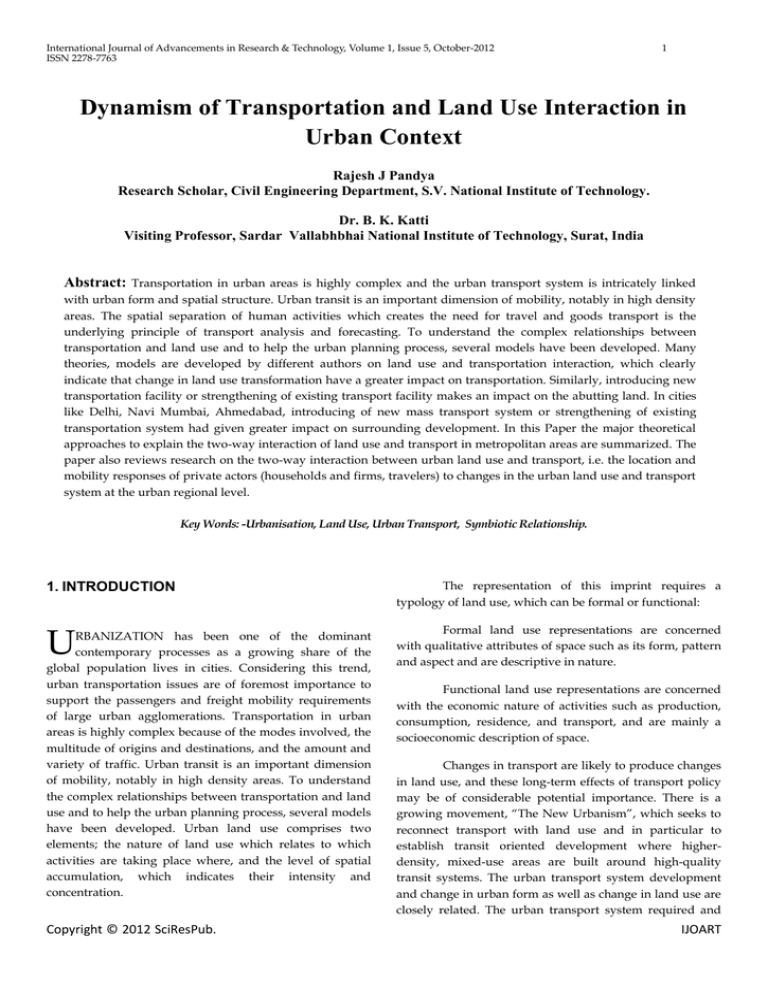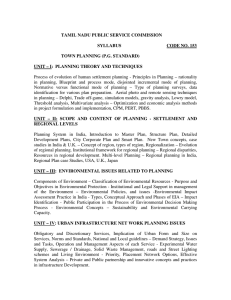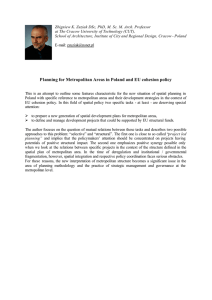Document 14671236
advertisement

International Journal of Advancements in Research & Technology, Volume 1, Issue 5, October-2012 ISSN 2278-7763 1 Dynamism of Transportation and Land Use Interaction in Urban Context Rajesh J Pandya Research Scholar, Civil Engineering Department, S.V. National Institute of Technology. Dr. B. K. Katti Visiting Professor, Sardar Vallabhbhai National Institute of Technology, Surat, India Transportation in urban areas is highly complex and the urban transport system is intricately linked with urban form and spatial structure. Urban transit is an important dimension of mobility, notably in high density areas. The spatial separation of human activities which creates the need for travel and goods transport is the underlying principle of transport analysis and forecasting. To understand the complex relationships between transportation and land use and to help the urban planning process, several models have been developed. Many theories, models are developed by different authors on land use and transportation interaction, which clearly indicate that change in land use transformation have a greater impact on transportation. Similarly, introducing new transportation facility or strengthening of existing transport facility makes an impact on the abutting land. In cities like Delhi, Navi Mumbai, Ahmedabad, introducing of new mass transport system or strengthening of existing transportation system had given greater impact on surrounding development. In this Paper the major theoretical approaches to explain the two-way interaction of land use and transport in metropolitan areas are summarized. The paper also reviews research on the two-way interaction between urban land use and transport, i.e. the location and mobility responses of private actors (households and firms, travelers) to changes in the urban land use and transport system at the urban regional level. Abstract: Key Words: -Urbanisation, Land Use, Urban Transport, Symbiotic Relationship. 1. INTRODUCTION The representation of this imprint requires a typology of land use, which can be formal or functional: U Formal land use representations are concerned with qualitative attributes of space such as its form, pattern and aspect and are descriptive in nature. RBANIZATION has been one of the dominant contemporary processes as a growing share of the global population lives in cities. Considering this trend, urban transportation issues are of foremost importance to support the passengers and freight mobility requirements of large urban agglomerations. Transportation in urban areas is highly complex because of the modes involved, the multitude of origins and destinations, and the amount and variety of traffic. Urban transit is an important dimension of mobility, notably in high density areas. To understand the complex relationships between transportation and land use and to help the urban planning process, several models have been developed. Urban land use comprises two elements; the nature of land use which relates to which activities are taking place where, and the level of spatial accumulation, which indicates their intensity and concentration. Copyright © 2012 SciResPub. Functional land use representations are concerned with the economic nature of activities such as production, consumption, residence, and transport, and are mainly a socioeconomic description of space. Changes in transport are likely to produce changes in land use, and these long-term effects of transport policy may be of considerable potential importance. There is a growing movement, “The New Urbanism”, which seeks to reconnect transport with land use and in particular to establish transit oriented development where higherdensity, mixed-use areas are built around high-quality transit systems. The urban transport system development and change in urban form as well as change in land use are closely related. The urban transport system required and IJOART International Journal of Advancements in Research & Technology, Volume 1, Issue 5, October-2012 ISSN 2278-7763 promoted by the high-density land-use pattern. There are many problems in the urban transportation and land-use, and in integration of urban transport planning and landuse planning. 2. THEORY OF LAND-USE TRANSPORT INTERACTION There is two-way interaction between urban land use and transport, i.e. the location and mobility responses of private factors (households and firms, travelers) to changes in the urban land use and transport system at the urban-regional level. That urban land use and transport are closely inter-linked is common wisdom among planners and the public. That the spatial separation of human activities creates the need for travel and goods transport is the underlying principle of transport analysis and forecasting. Following this principle, it is easily understood that the suburbanization of cities is connected with increasing spatial division of labor, and hence with ever increasing mobility. However, the reverse impact from transport to land use is less well known. There is some vague understanding that the evolution from the dense urban fabric of medieval cities, where daily mobility was on foot, to the vast expansion of modern metropolitan areas with their massive volumes of intraregional traffic would not have been possible without first the rail-way and then the private automobile, which has made every corner of the metropolitan area almost equally suitable as a place to live or work. However, exactly how the development of the transport system influences the location decisions of landlords, investors, firms and households is not clearly understood even by many urban planners. Hence we have mentioned the major theoretical approaches to explain the two-way interaction of land use and transport in metropolitan areas. 2.1 Technical Theories: Urban Mobility Systems Cities appeared in human history when technological innovation required the division of labor, i.e. when specialised crafts separated from agricultural labor (Sombart, 1907). The concentration of specialised skills in larger settlements released a 'tremendous expansion of human capabilities' and called for protection and exchange: the citadel and the market became the primeval urban functions (Mumford, 1961). Based on this paradigm, the first explanations for the location and growth and decline of cities are technical: cities were established on trade routes, ports or river crossings. Classic examples of transport-generated cities are Venice and Genoa, the wealth of which was based on Copyright © 2012 SciResPub. 2 their sea routes, or the many cities in Europe with names ending in -ford or -furt, such as Hereford or Frankfurt. These cities declined once their locational advantage disappeared, as happened to Venice and Genoa when the discovery of the sea passage to India took their sea trade away. The recognition that trip and location decisions codetermine each other and that therefore transport and landuse planning needed to be coordinated, quickly spread among American planners, and the 'land-use transport feedback cycle' became a commonplace in the American planning literature. The set of relationships implied by this term can be briefly summarised as follows (see Figure 1.) The distribution of land uses, such as residential, industrial or commercial, over the urban area determines the locations of human activities such as living, working, shopping, education or leisure. The distribution of human activities in space requires spatial interactions or trips in the transport system to overcome the distance between the locations of activities. The distribution of infrastructure in the transport system creates opportunities for spatial interactions and can be measured as accessibility. The distribution of accessibility in space co-determines location decisions and so results in changes of the landuse system. The theories based on this paradigm start from observed regularities of certain parameters of human mobility, such as trip distance and travel time, and from these try to infer those trip origins and destinations that best reproduce the observed frequency distributions. It had long been observed by Ravenstein (1885) and Zipf (1949) that the frequency of human interactions such as messages, trips or migrations between two locations (cities or regions) is proportional to their size, but inversely proportional to their distance. The analogy to the law of gravitation in physics is obvious. The gravity model was the first spatial interaction (or in short SIA) model. Its straightforward physical analogy has later been replaced by better founded formulations derived from statistical mechanics (Wilson, 1967) or information theory (Snickars and Weibull, 1976), yet even after these substitutions the SIA model did not provide any explanation for the spatial behavior modeled. Only later did it become possible (Anas, 1983) to link it via random utility theory (McFadden, 1973) to psychological models of human decision behavior (Luce, 1959) IJOART International Journal of Advancements in Research & Technology, Volume 1, Issue 5, October-2012 ISSN 2278-7763 3 Figure 1. The 'land-use transport feedback cycle'. 2.2 Economic Theories: Cities as Markets. A second set of theories focuses on the economic foundations of city growth. Following this paradigm, it is the market function that distinguishes the city from the countryside (Weber, 1921; 1925). Other authors define trade and crafts as the two activities constituting a city (Sombart, 1907): cities come into being if craftsman and farmer are different persons. Thus the city is a product of specialisation and the division of labor. Historically city growth in Europe has been closely linked to economic structural change as, during the first industrial revolution, rural-to-urban migration went hand-in-hand with the reduction in agricultural and the growth in industrial employment. In regional economics this is called the economic base theory, which implies that the regional income, and hence the number of people a region can support, depends on its exports. In its dynamic form, the economic base theory comes in two versions, one equalizing and one polarizing. The theory of spatial economic equilibrium assumes perfect competition and perfect factor mobility and hence predicts equal factor prices, productivity and commodity prices in all regions (Ohlin, 1933). The theories of growth poles (Perroux, 1955) or circular cumulative causation (Myrdal, 1957), however, predict polarization between central and peripheral regions because of economies of scale and enhanced possibilities of innovation in the larger industries at the centre. Copyright © 2012 SciResPub. Figure 2 The Britchie Triangle 2.3 Social Theories: Society and Urban Space In social sciences theories of urban development the spatial development of cities is the result of individual or collective appropriation of space. 2.4 'Ideal' Land-Use Transport Systems The review of land-use transport interaction theory in the previous section revealed that there exist close interactions between land-use and transport systems. This section contains a brief overview of configurations of landuse and transport systems which were considered to be ideal in a given set of preconditions and objectives. The approaches presented here are comprehensive policies which attempt to influence not only mobility patterns but also social and economic processes by means of urban form. The following presentation is focused on the most important structural characteristics of 'ideal' land use transport systems in order to give an overview of the typology of possible spatial city structures. Comprehensive descriptions can be found in Benevolo (1980), Hall (1988) and Fürst et al. (1999). IJOART International Journal of Advancements in Research & Technology, Volume 1, Issue 5, October-2012 ISSN 2278-7763 2.5 Contemporary Proposals 4 employment is thus the result of a multiplier effects on the basic sector. Presently three basic concepts of urban development rooted in the prototypes of land-use transport systems described above are concurrently being discussed. 2.6 Compact City The compact-city policy is based on a strategy of reducing the expansion of urbanised areas thus protecting the surrounding environment and creating a distinct contrast between urban and rural areas. The compact-city model implies intensive land use patterns and a predominantly monocentric urban macrostructure. Municipalities which pursue a compact-city policy regularly promote urban regeneration and brownfield projects, take measures to enhance the quality of living in inner-city residential areas and prioritise improvements in public transport service over investments in automobile infrastructure. 3. LOWRY’S MODEL 3.1 Concept The Lowry model was one of the first transportation / land use model to be developed in 1964 for the Pittsburgh region. Even if its formulation is rather simple, it depicts well the relationships between transportation and land use. Its premises were expended by several other models, known as "Lowry-type" models. The core assumption of the Lowry model assumes that regional and urban growth (or decline) is a function of the expansion (or contraction) of the basic sector. This employment is in turn having impacts on the employment of two other sectors, retail and residential. The flow chart gives the logic of the Lowry model. It is demand driven. First, the model responds to an increase in basic employment. It then responds to the consequent impacts on service activities. As Lowry treated his model and as the flow chart indicates, the model is solved by iteration. But the structure of the model is such that iteration is not necessary. Overall, the Lowry model has three assumptions: The residential sector, and thus urban land use, is a function of employment. This function is calculated assuming multiplier effects of basic and non-basic employment. Each job is thus linked to a number of people. The total employment is a function of the employment in the basic sector. The retail Copyright © 2012 SciResPub. Fig No.3 Logic of Lowry Model 3.2 Variables and Model The model can be singly constrained, that is the only constraint is the fixed location of basic employment. It can also be doubly constrained, where the location of basic employment and housing are fixed. The Lowry model has obviously several limitations. It is notably a static model, which does not tell anything about the evolution of the transportation / land use system. Furthermore, current economic changes are in the service (non-basic) sectors, forming the foundation of urban productivity and dynamics in many metropolitan areas. Under such circumstances the model is likely to be inaccurate in the major service-oriented metropolitan areas of today. A way to overcome this issue is to consider some non-basic service employment as basic. The Lowry model does not consider movements of freight in urban areas, which are very significant and have impacts on the friction of distance. 3.3 Future Urban Land-Use Transport Models IJOART International Journal of Advancements in Research & Technology, Volume 1, Issue 5, October-2012 ISSN 2278-7763 Today there are many urban modeling projects in Europe underway. The MEPLAN model is applied in more and more cities all over the world. The European Commission has funded a number of important studies employing land usetransport models. 2. 3. 4. REMAINING CHALLENGES 4. Nevertheless, there are challenges still to meet. The transport submodels used in existing land use transport models do not apply state-of-the-art activity-based modeling techniques. All of them apply the traditional four-step travel demand model sequence which is not suitable to model behavioural responses to many travel demand management policies presently discussed. Moreover, the spatial resolution of existing land-use transport models is too coarse to model activity-based travel behaviour or neighborhood-scale travel demand management policies. 5. 6. 7. 8. 5.CONCLUSION Both land use and transportation are part of a dynamic system that is subject to external influences. Each component of the system is constantly evolving due to changes in technology, policy, economics, demographics and even culture/values, among others. As a result, the interactions between land use and transportation are played out as the outcome of the many decisions made by residents, businesses and governments. 9. 5 Commuting Behavior, Travel Model Improvement, USDOT (www.bts.gov). Comprehensive Mobility Plan of Surat City Daniel A. Badoe and Eric Miller (2000), “Transportation-Land Use Interaction: Empirical Finding in North America, and Their Implications for Modeling,” Transportation Research D, Vol. 5, No. 4, (www.elseier.com/locate/trd), July 2000, pp. 235-263. Detailed Project Report of Bus Rapid Transit System – A Case Study of Surat City Dr. Jean-Paul Rodrigue, Urban Land Use and Transport, http://people.hofstra.edu/geotrans/ Exploring The Relationships Between Land-Use System And Travel Behaviour: Some First Findings, 45th Congress of the European Regional Science Association, 23-27 August 2005, Vrije Universiteit Amsterdamhttp://www.feweb.vu.nl/ersa2005/final_paper s Geetam Tiwari, Transport and Land Use Policies in Delhi Michale Wegener, Land Use Transportation Interaction: State of Art, , Deliverable 2a of the project TRANSLAND (Integration of Transport and Land Use Planning) of the 4th RTD Framework Programme of the European Commission. Todd Litman and Rowan Steele, Land Use Impact on Transport: Victoria Transport Policy Many theories, models are developed by different authors on land use and transportation interaction, which clearly indicate that change in land use transformation have a greater impact on transportation. Similarly, introducing new transportation facility or strengthening of existing transport facility make an impact on the abutting land. In cities like, Delhi, Navi Mumbai, Ahmedabad introducing of new mass transport system or strengthening of existing transportation system had given greater impact on surrounding development. From the study of various land use theories, land use models and various examples of the cities, it is proven that land use and transportation has greater impact on each other. City Planner, City Administrator has to understand and take care of this issue while city planning. Different land use transport policy has to be developed by different cities / state according to the development, which ultimately make city livable. REFERENCES 1. Cambridge Systematics (1994), The Effects of Land Use and Travel Demand Management, Strategies on Copyright © 2012 SciResPub. IJOART





